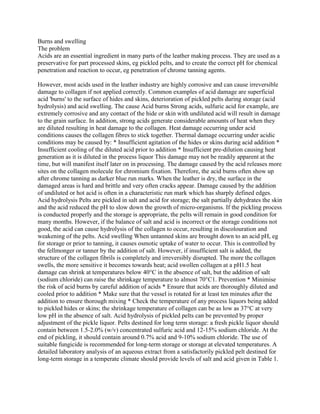
Prevent burns, swelling from acid in leather process
- 1. Burns and swelling The problem Acids are an essential ingredient in many parts of the leather making process. They are used as a preservative for part processed skins, eg pickled pelts, and to create the correct pH for chemical penetration and reaction to occur, eg penetration of chrome tanning agents. However, most acids used in the leather industry are highly corrosive and can cause irreversible damage to collagen if not applied correctly. Common examples of acid damage are superficial acid 'burns' to the surface of hides and skins, deterioration of pickled pelts during storage (acid hydrolysis) and acid swelling. The cause Acid burns Strong acids, sulfuric acid for example, are extremely corrosive and any contact of the hide or skin with undiluted acid will result in damage to the grain surface. In addition, strong acids generate considerable amounts of heat when they are diluted resulting in heat damage to the collagen. Heat damage occurring under acid conditions causes the collagen fibres to stick together. Thermal damage occurring under acidic conditions may be caused by: * Insufficient agitation of the hides or skins during acid addition * Insufficient cooling of the diluted acid prior to addition * Insufficient pre-dilution causing heat generation as it is diluted in the process liquor This damage may not be readily apparent at the time, but will manifest itself later on in processing. The damage caused by the acid releases more sites on the collagen molecule for chromium fixation. Therefore, the acid burns often show up after chrome tanning as darker blue run marks. When the leather is dry, the surface in the damaged areas is hard and brittle and very often cracks appear. Damage caused by the addition of undiluted or hot acid is often in a characteristic run mark which has sharply defined edges. Acid hydrolysis Pelts are pickled in salt and acid for storage; the salt partially dehydrates the skin and the acid reduced the pH to slow down the growth of micro-organisms. If the pickling process is conducted properly and the storage is appropriate, the pelts will remain in good condition for many months. However, if the balance of salt and acid is incorrect or the storage conditions not good, the acid can cause hydrolysis of the collagen to occur, resulting in discolouration and weakening of the pelts. Acid swelling When untanned skins are brought down to an acid pH, eg for storage or prior to tanning, it causes osmotic uptake of water to occur. This is controlled by the fellmonger or tanner by the addition of salt. However, if insufficient salt is added, the structure of the collagen fibrils is completely and irreversibly disrupted. The more the collagen swells, the more sensitive it becomes towards heat; acid swollen collagen at a pH1.5 heat damage can shrink at temperatures below 40°C in the absence of salt, but the addition of salt (sodium chloride) can raise the shrinkage temperature to almost 70°C1. Prevention * Minimise the risk of acid burns by careful addition of acids * Ensure that acids are thoroughly diluted and cooled prior to addition * Make sure that the vessel is rotated for at least ten minutes after the addition to ensure thorough mixing * Check the temperature of any process liquors being added to pickled hides or skins; the shrinkage temperature of collagen can be as low as 37°C at very low pH in the absence of salt. Acid hydrolysis of pickled pelts can be prevented by proper adjustment of the pickle liquor. Pelts destined for long term storage: a fresh pickle liquor should contain between 1.5-2.0% (w/v) concentrated sulfuric acid and 12-15% sodium chloride. At the end of pickling, it should contain around 0.7% acid and 9-10% sodium chloride. The use of suitable fungicide is recommended for long-term storage or storage at elevated temperatures. A detailed laboratory analysis of an aqueous extract from a satisfactorily pickled pelt destined for long-term storage in a temperate climate should provide levels of salt and acid given in Table 1.
